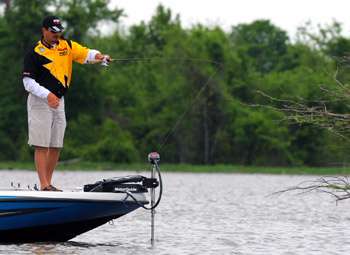
The Red River Open was tough last week, no doubt about it. But several anglers, using very different techniques, got the job done. Here's how they did it.
1st place:
Billy McCaghren, Jr.
(54 pounds)
"Every fish I caught over the three days was caught on a 6-inch junebug Berkley Power Lizard," said the pro from Mayflower, Ark. "I used a Texas rig with Tru-Tungsten weights in either 1/2-, 3/8- or 5/16-ounce sizes, depending upon the wind. I used the lightest weight possible that would let me pitch into the wind. My hook was a round bend 3/0 Gamakatsu worm hook."
He targeted the root systems around green cypress trees in relatively deep water. "The water was up, and I found a backwater pond in 4 to 7 feet of water with a lot of green cypress trees growing in it. I pitched to their roots all three days."
On Day 1 he found his bass deep in the roots along the bottom muck. But, as the tournament progressed, the fish moved up in the water column and were suspended in the roots that grow horizontally off the trunk, above the bottom but still below the surface.
"On Thursday they were deep on the bottom. I had to move the bait very slow, just barely inch it along, to get a bite. Hardly any movement at all would turn them off.
"But after that I had to pull the lizard up into the higher roots and shake it to get bit. I don't know what caused them to move up that way, maybe they were spawning, but I can't say for sure," he said.
"No matter where they were, though, a vertical presentation was the key. The bait had to drop straight down into, and through, the roots to attract their attention. I pegged my sinker to help me get this effect and also used Berkley 100% Fluorocarbon line. It sinks quickly, and that helped, too."
He pitched his plastic with an Abu-Garcia Revo reel mounted on a 6 ½-foot, G.Loomis IMX medium-heavy action rod.
Interestingly, McCaghren says he didn't feel even one bite during the tournament. "The line would twitch or start moving off, and that's how I knew I had a bite. But, after I landed them they had the bait way back in their throats so they were definitely eating. I don't know what was happening."
3rd place:
Jerry Williams
(50 pounds, 12 ounces)
"I was fishing the lower ends of the pools where the water wasn't so high," said Williams. "Most of my fish came from isolated wood and grass in shallow water."
When the wind was down he was able to fish the isolated wood with a green pumpkin Baby Brush Hog, rigged Texas style with a 3/16-ounce black Tru-Tungsten weight and a 3/0 Gamakatsu worm hook.
"I pitched my Baby Brush Hog right alongside the wood and let it drop straight down on a slack line. The bass really didn't hit it. They just sort of carried it off. There wasn't even a swirl, just sideways movement. But, every time I set the hook there was a good fish on my line, so obviously they were sucking it in."
When the wind increased, the fish moved away from the wood. Williams was forced to fish the grass with a 3/8-ounce, chartreuse and white Strike King Kevin VanDam spinnerbait.
"The grass bite was different from the wood bite. I think I was fishing flooded dry ground growth — it was green with red flowers on top of it — in less than a foot of water. I ran the spinnerbait just under the surface. I learned to do that back in my hometown of Conway, Ark., and thought it might work here. It did!
"If I didn't get a strike in the grass, I'd crank the bait on out past the outside edge of the grass and let it fall vertically. Sometimes that would get me an extra bite or two from a patch that I thought was used up."
Williams pitched with 20-pound-test Seaguar Invizx line, a Pflueger President reel and a 7 ½-foot, heavy action All Star rod. He threw his spinnerbait with the same line spooled on a Pflueger Trion reel and a 7-foot medium-heavy All Star rod.
5th place:
Danny Smith
(45 pounds, 7 ounces)
"I concentrated exclusively on the shallow backwater areas," said Smith. "I found some spots with very heavy wood cover in them, and that's all I fished."
Smith reported that his best keeper bass all came from the biggest wood in the immediate area, on the shady side of the cover. "I really don't know why, but the biggest bass were hiding along the biggest wood. The wood didn't really have to be all that big as long as it was the biggest in the area."
His weapon of choice was an out of production jig called the Crawgator Jig, originally made by Cajun Tackle. According to the Monterey, La., professional this jig is special and his first choice for fishing heavy wood.
"The head is shaped much like a worm weight, and the line tie is recessed down in the head. These two features allow the jig to drop straight down and avoid hang-ups that can be a problem with other jigs," he explained. "I bought a bunch of them before they went out of business so I could have them for tournaments."
Crawfish was his best color — black, brown, red — with a Zoom Super Chunk (green pumpkin) and a chartreuse dyed tail. "The chartreuse was very important. The water was stained. I think they could see the bait with chartreuse tails better."
He pitched his jig to visible wood using 20-pound-test Berkley Trilene Big Game line spooled on a Pinnacle reel mounted to a 7-foot, G. Loomis 785 heavy action rod.
